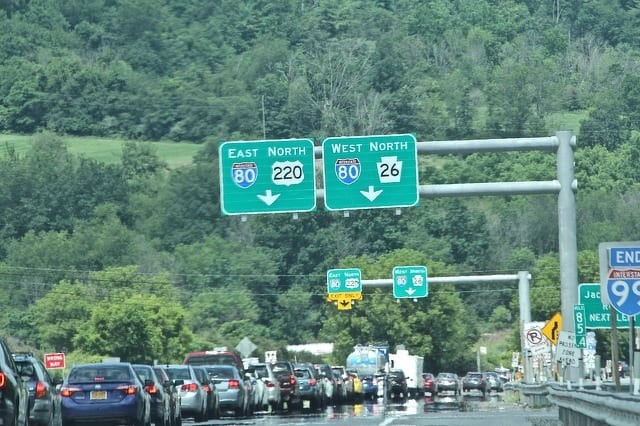MARION TOWNSHIP — The interchange between interstates 99 and 80 could be described as chaotic, troublesome and dangerous.
Each day, some 24,000 vehicles pass along I-80 alone, with 48 percent of traffic being trucks. The I-99 innovation corridor sees an average of 22,765 vehicles per day, of which 16 percent are trucks. When those interstates come together in Marion Township, they do not actually intersect.
The state Department of Transportation, with the collaboration of the Metropolitan Planning Organization and county and local governments, has submitted a $43 million grant request to the federal government’s INFRA program, with the rest of the total of $183 million coming mostly from PennDOT and an MPO contribution of $8 million.
The hope is to use the grants to connect Interstates 99 and 80 using a high-speed interchange and constructing a local access interchange farther to the east in Marion Township that will tie into Route 26. Other related projects are planned, too.
Local governments and organizations have been quick to jump on board with local support, often a requirement for such grants or a showing that at the very least increases the chances of a grant award.
The Chamber of Business and Industry of Centre County organized the Drive Forward campaign to solicit public support for the project.
Most recently, the Bellefonte Area School District on Nov. 21 voted unanimously to pass a resolution in support of the grant application and the MPO’s efforts.
Board president Rodney Musser said it was important to get the project done as soon as possible since 278 students on six buses make use of I-99.
Jon Guizar also spoke in favor of the project, noting that it was a very dangerous and frustrating situation, and the district has been fortunate there have not been more accidents in the area.
The daily push does not include the context of major sports games, holidays or other events, where traffic can become backed up on the right lane of I-80. The stop sign after exiting I-80 is a full 1,350 feet away from the interstate’s main line.
Traffic also can become backed up on Route 26, where queues can often extend 300 feet for people waiting to make a left turn onto I-80, according to the grant application. About 70 percent of all crashes take place during daylight hours in dry conditions. Angle crashes account for 77 percent of crashes, which is double the predicted number for this type of intersection.
Transportation planners, including Tom Zilla for the MPO, have pointed out this intersection would not meet current design criteria, which demands that two intersecting interstate highways be linked using high-speed transitions.
Right now, Route 26 connects the mile separating the two highways, providing for the project’s colloquial name of “The Last Mile.” Route 26 sees an average of 19,629 vehicles per day at the interchange.
At this point, during major events, PennDOT will spend $10,000 on flaggers for Exit 161 from I-80.
Zilla said in an earlier interview the grants are incredibly competitive. The previous grant system under the name FASTLANE saw 212 applications in 2016, but only 17 were eventually recommended for funding.
All of the grants and contributions actually will be split to fund three different projects related to the interchange. The first is an I-80 local access interchange with Route 26. The $43 million project, if funded, could begin construction in September 2019 and be completed by around December 2021. It would also serve to replace two bridges along I-80’s mainline.
The second project is the Jacksonville Road “betterment section 2,” which would widen the existing road to provide for 11-foot travel lanes and 4-foot shoulders at a cost of $6 million, and would be completed later, perhaps around December 2022.
Last would come the high-speed interchange. That, on current proposals, is not slated to be completed until 2024 and would cost a projected $127,187,926.
Additionally, the interchange would be built to support Penn State University’s Autonomous Vehicle Program, which would use the area as a “test bed for new transportation technology,” according to the INFRA proposal.



